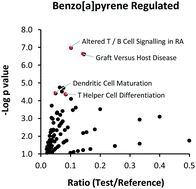Bronchial epithelial innate and adaptive immunity signals are induced by polycyclic aromatic hydrocarbons†
Abstract
Polycyclic aromatic hydrocarbons including Benzo[a]pyrene have been recognised as important pollutant chemicals with the potential to influence the respiratory system in disease. Airway epithelial cells are an integral component of how immune responses are directed as a consequence of exposure to inhaled material. It was aim of this study to examine how such cells respond to PAH exposure and to characterise the immune response. Human primary bronchial epithelial cells (HPBECs) were exposed to Benzo[a]pyrene, Benzo[e]pyrene, Fluoranthene and Benzo[b]fluoranthene for 24 h and a repeat exposure up to 7 days, and examined for global gene expression using RNA-Seq. In addition to increased expression of CYP1A1 and other AHR dependent changes, we identified significant increases in innate and adaptive immune signals including, IL-1A, IL-19, SERPINB2, STAT6, HLA-DMB and HLA-DRA. We also observed increased expression of HMOX1 and NQO1, genes involved in the response to oxidative stress. Immune system related gene expression was differentially induced by each compound with Benzo[a]pyrene and Benzo[b]fluoranthene demonstrating the most potent responses. Differential induction paralleled the level to which AHR dependent gene expression and oxidative stress markers were induced. We also observed similar levels of gene expression when cells were exposed to organic extracts from diesel exhaust particles. In conclusion, hazard characterisation of responses to PAH exposure in HPBECs highlights specific responses of both innate and adaptive immunity.


 Please wait while we load your content...
Please wait while we load your content...